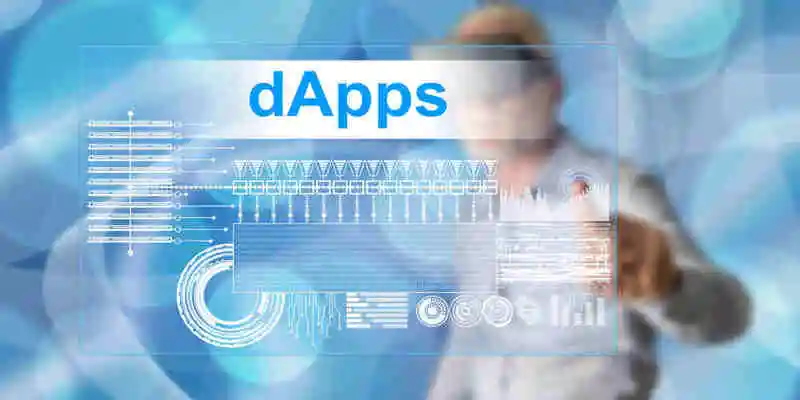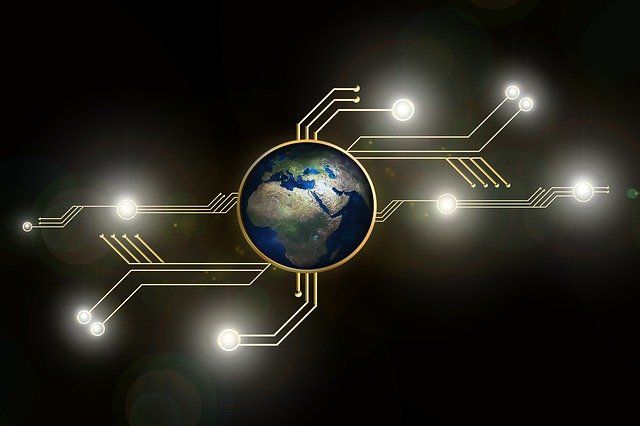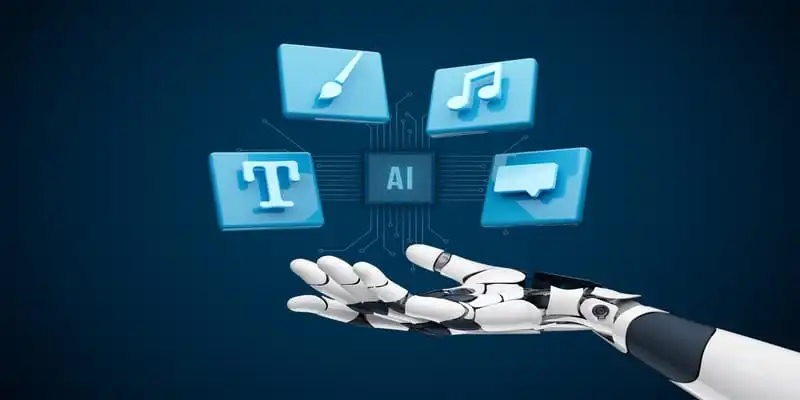Everything You Need to Know About dApps (Decentralized Apps)
Decentralized apps, or dApps for short, are the next step in app development. They are built on decentralized networks that use blockchains. Many blockchain projects have recently made it a reality, making blockchain-based security easier to maintain, more secure, and cost-efficient.

DApps are an intriguing technology that has yet to be fully realized.
According to a Blockchain Examiner report, the "market size of Dapps is predicted to reach USD 21,070.2 million by the end of 2025." Axie Infinity, a videogame, is an example of how DeFi protocols are gradually generating money, with a revenue production of over USD 300 million in August 2021.
Aside from the obvious financial benefits, inventing to produce new solid DApps will benefit the globe. Decentralized online market DApps are an enticing technology quickly becoming the new standard for app development across several fields. The customers have complete control over a decentralized e-commerce app. They can also share suggestions on platform improvements and transactions.
What Exactly is a Decentralized App?
Decentralized apps, or dApps, operate on a peer-to-peer basis with no centralized entity to manage and supervise the operation. These don’t always require only two end users to complete a transaction for a given system. In contrast, dApps can have an infinite number of end users.
DApps in History
Although Bitcoin (BTC) was the first blockchain network, the technology has progressed beyond a primary financial transaction. When Vitalik Buterin and his colleagues suggested Ethereum (ETH) in 2013, they had a far bigger goal: a decentralized way of living.
Buterin envisioned a blockchain-based internet where consumers controlled the internet rather than businesses. To do so, Ethereum would power intelligent contracts, simply automated if-then statements. Because rules and constraints were baked into their coding, these contracts are unchangeable. Any party can deal without the requirement for a middleman, eliminating the necessity for centralized platforms.
Surprisingly, in 2014, a study defining the DApp, titled "The General Theory of Decentralized Applications, Dapps," was published. It was prepared by a group of experts in the field, including David Johnston and Shawn Wilkinson.
DApps were defined in the study as entities having the following characteristics:
- A DApp must be open-source and run without the interference of a third party.
- It must be user-controlled because users may suggest and vote on modifications that are automatically applied. A DApp establishes a new framework for business processes by allowing all network members to track what is going on rather than just one person. They are regulated by autonomy, and any DApp modifications are decided by consensus. A DApp's codebase should be open for scrutiny.
- All data must be stored in a blockchain network that is open to the public. Decentralization is essential since there can be no one point of attack.
DApps must use a cryptographic token for access and must compensate contributors in the token, such as miners.
A DApp must contain a token-generating consensus technique, such as proof-of-work (PoW) or proof-of-stake (PoS).
The report then divides DApps into three "categories" or "layers" based on how users interact with them.
Decentralized Application Classification
DApps are now classified into three types:
- Type 1: DApps have their blockchains, for instance, Bitcoin and DogeCoin.
- Type 2: DApps in type 2 use blockchains mentioned in type 1. These are based on specific protocols and demand tokens for proper working. For instance, Omni Protocol helps develop and use intellectual properties and supports user currencies and other smart contracts. OMNIs is a junction between blockchains, properties, and smart contacts created on Omni Protocol.
- Type 3: DApps in this category use type 2 protocols; an example includes the SAFE Network as it is the world's first autonomous data network. It preserves whole data and makes it available online indefinitely. It allows censorship-resistant website development and applications. Further, it creates SAFEcoins by using Omni Protocol.
What is the Purpose of DApps?
DApps bridge the gap between present Web 2.0 platforms and Web 3.0, the internet's future in which decentralization is crucial. Blockchain is still in its initial stages; there are fewer dApps than regular apps. However, a steady stream of innovation has broadened the application ecosystem. So, what can we forecast from the future of dApps? What do they resemble, and what do they serve? Here are a couple of such examples:
Wallets for Cryptocurrencies
Crypto wallet decentralized applications (dApps) are critical components of the decentralized Web 3.0 ecosystem. To buy, trade, and exchange cryptocurrencies, crypto wallets, which can be custodial or non-custodial, are necessary. Custodial wallets are platforms that hold your private keys, which are analogous to your account PIN or password.
Binance and Coinbase are two examples of custodial wallets. You control non-custodial wallets, which means no one else can access your private keys. ZenGo and Edge are two examples.

- Decentralized Exchanges (DEXs)
DApps are frequently accessible using a web browser. When you visit the DEX web address (URL), you'll see an interface where you may connect your bitcoin wallet to the website or platform. After that, you may interact with the DEX dApp and use supported features such as liquidity pools, lotteries, NFT markets, and more.

- Gaming
Decentralized gaming is a prominent component of the blockchain ecosystem. Non-fungible tokens (NFTs) are utilized in popular game dApps such as Splinterlands, Axie Infinity, and My DeFi Pet to preserve players' value in the metaverse. As a player, you may purchase specialized in-game things such as NFTs, boosting your gaming experience by amassing a one-of-a-kind collection of weapons or accessories.
- Platforms for Social Media
Steemit and other social media dApps foster online conversation in the same way that Facebook and Instagram do. dApps, on the other hand, reverse the flow of value and reward you for engaging in the network rather than gathering and selling your data.
However, Blockchain-based DApps operate on a peer-to-peer (P2P) paradigm, which implies that nodes can communicate with one another.
What Role Do DApps Play in the Real World?
There are presently over 4,000 dApps available globally, ranging from gaming and gambling to health and insurance. While games and exchanges are the most popular Ethereum dApp genres, banking apps have progressively gained momentum in recent years. Still, growth has been slower than expected; dApps have been around since 2015; why aren't they built more quickly?
Developers must design user-friendly applications, but there aren't many organizations and consumers adopting blockchain-based networks, making it harder to propel an app to success. However, given the ongoing advancement of blockchain, edge computing, and mobile computing, control distribution is inescapable, and the introduction of dApps is already a consistent trend. Now it's time for businesses to pay closer attention to what is going on and how it impacts them and their target audience.
Bitcoin is considered one of the first known dApps. Bitcoin is widely regarded as the apex currency that addresses the problems of centralization by empowering individuals to perform transactions without the assistance of a mediator or centralized authority. When it comes to dApps, we may categorize them based on the context in which they can be used. This taxonomy divides dApps into three categories that correspond to their probable use cases:
-
Managing and Transferring money
These apps can be used to make global money transfers more efficient. We have already witnessed the benefits of bitcoin and other cryptocurrencies' success. dApps can use a blockchain network and its crypto token to accelerate money transfer, management, and lending by eradicating intermediaries and increasing confidence due to the agreement, which cannot be altered without majority consent. -
Management of Business Processes
Enterprises can incorporate decentralized apps to automate activities that do not require human participation. Critical difficulties may be handled, and process efficiency can be improved with smart contracts, a crucial cog in the blockchain network. Logistics businesses, for example, may incorporate “RFID chips” into their shipments that can be read at destination ports allowing instant payment through a contract between seller and buyer. -
Decentralized Autonomous Organization (DAO)
In advanced DAO, organizations without faces are being created. These companies can function as a corporation and follow regulations specified by blockchain programming languages. The organization operates in which business area? Who will be the members, and how will token exchange take place? The blockchain that will manage the company may be programmed with everything. Once installed, these firms cannot halt and may operate while riding the blockchain network bandwagon.
Top 5 DApp Projects in the Real World
The first dApp was Bitcoin, which allowed everyone to download open-source code and join the blockchain network, validating contracts in return for digital money using a mining algorithm.
The following are the top dApps on the market:
1. Brave
With over 9 million active users, the web browser recently gave Chrome browsers a run. Brave seeks to turn the internet advertising business head by putting customers in control. The software establishes a new metric for advertising value, in which "customer attention" is of high worth than unverified clicks and views on web pages.
Brave gained more popularity than its alternative ways because of its uniqueness, and one of its founders is exceptional at developing Mozilla's Firefox— economic strategy.
Chromium is an open-source project run by Google, V8 JavaScript engine, and Blink rendering engine; Brave is also built on it.
2. Golem
It is a dApp that shares a worldwide place for underutilized computer strength. This project aims to join the strengths of computers and data places to create a supercomputer that anybody worldwide may utilize (rentable). These vendors can exchange their goods for GNT tokens. The project has significant promises since it enables decentralized rendering, which is quicker and less expensive than centralized systems.
3. TRACEDonate
TRACEDonate's access control solution is intended to make cross-border payments and donations transparent and traceable. Blockchain technology is utilized to validate the uniqueness of the generous company and the individual to whom a contribution is done. The funds stay in a digital wallet, so, the payer can also trace how they are spent. Moreover, the payers can specify the purpose of donation, such as for healthcare assistance, education, or other relief supplies.

4. Circulor
Circulor is a supplier traceability application used in the electric drive and electronics industries. It certifies that the building ingredients used in its manufacture were obtained morally and ethically. Circulor is a “track-and-trace program” that enables clients to do protected shipments, process fees, and validates the origin of raw resources. It is intended to manage intricacy in real-world. DApps have specific qualities that allow investors to spend in creating dapps with the potential to convert them into self-sustaining assets.
DApps, for various reasons, including transactions, data, and cloud services, are anticipated to outperform available old apps in terms of use. Current techniques will become obsolete when cryptocurrency becomes ubiquitous. Although it may look unlikely now, organizations such as banks will implement blockchain soon and work on fully decentralized and independent systems. Major organizations started moving to protect their position in the digital environment.
5. KYC Chain
This software is used by businesses to confirm client IDs and speed up the KYC compliance process flow. It uses partnership sanctions with over 240 countries that help verify individuals and commercial institutes for prohibited or criminal acts. These chains store the user’s data and keep it private from open access. Thanks to a self-superior identity app partner, SelfKey, that offers public keys to access information when needed. The app users can pay service fees, including official investor verification, fund testing, document validation, and Id checking while using this application. It also helps users to compare their spending in crypto wallet expenditures and assure compliance with anti-money laundering rules and regulations.
The shapeShift-based project, Prism, developed on Ethereum Blockchain, ensures financial market trustworthiness and decentralization. It joins with EDCCs to develop asset management solutions and executable code contracts. The project also allows investment in several coins set their keeping percentages. It doesn’t demand third-party mediators and eliminates time-catching processes for maintaining several transactions and accounts. Plus, you don’t have to keep a record of passwords and keys as the system is developed on Ethereum smart contract. Its interactive interface tells the person’s investment technique rightly in real-time.
What Are the Top Benefits of dApps?
dApps' unique structure has many key benefits over more standard server-client software: they are intrinsically safe, easy to connect with cryptocurrencies, and may function completely independent of corporate interference.
-
1.Inherent Safety
Because they often rely on a blockchain to store sensitive data, dApps are designed to protect against any intrusion by anybody attempting to modify that data to steal money or restrict any content. Because each input is included in the hashed value of the next entry, it is feasible because a blockchain maintains information in a fashion that cannot be modified unless all its hosts agree that the change is genuine. -
Cryptocurrency Integration Made Simple
DApps use cryptocurrencies; the technology on which dApps rely was introduced by Bitcoins, and cryptocurrency transactions continue to be the most common use of the technology. By compensating content providers and motivating users to run a "full node" - a duplicate of the dApp's whole blockchain that accepts incoming transactions and perhaps validates them through "mining," cryptocurrencies can increase activity on the site.
dApps that employ cryptocurrencies generate an internal token unique to the platform; these are frequently built on Ethereum and connected with its blockchain since the ERC-20 standard of that currency makes it simple to generate a unique token.
Most traditional apps rely on their developers or some other central authority to enable transactions and make platform-level decisions, but dApps run on their own once launched. It's exciting to observe how the technology evolves as more software developers get interested in dApps.
Drawbacks of DApp Development
- Ongoing maintenance - Dapps are tough to administer since the code and data posted to the blockchain are more challenging to modify. Even if defects or security concerns are identified in an older version, it's difficult for developers to update their decentralized applications (or the underlying data retained by a dapp) after they've been launched.
- Performance overhead - It is a substantial performance cost, and scaling is challenging. Every node analyzes and records every transaction to guarantee the privacy, stability, transparency, and dependability that Ethereum aspires for. Furthermore, proof-of-work is time-consuming.
- Network congestion - When a single dapp takes a large amount of processing power, the entire network suffers. The network can only process roughly 10-15 transactions per second right now; if transactions were delivered faster, the pool of unverified transactions would quickly rise.
- User experience - Creating user-friendly experiences might be more difficult since the average end-user may find it too complex to properly set up the required tool stack for engaging with the blockchain.
Conclusion
In the last few years, dApps have made tremendous progress. For many dApps, both the ease of usage and the value of their tokens have improved dramatically. This dApp development is intriguing to watch in the following years because if it continues, we should not be shocked if many of these dApps are utilized by customers regularly.



